
History of Pirate Surgeons Menu: 1 2 3 4 5 6 7 8 9 10 11 12 Next>>
The History of Sea and Pirate Surgeons, Page 11
Bartholomew Robert's Seven Named Pirate Surgeons
Pirate commodore Bartholomew Roberts spent over two and half years on the account,
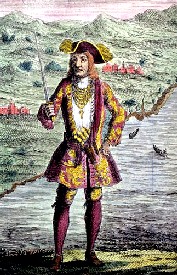
Bartholomew Roberts (1724)
capturing more than 400 ships, making him one of the most successful pirates during the golden age of piracy. It should not be surprising that a variety of surgeons served Roberts on one or the other of his ships during this sprawling career. Most of what we know of Roberts' surgeons comes from the trial following his death. Seven named medical men are associated with Roberts including doctors Hunter and Hamilton, Archibald Murray, William Child, Adam Comrie, George Wilson and Peter Scudamore. Murray was discussed previously, having served under pirate captains Howell Davis and Walter Kennedy as well as Roberts.
Of doctors Hunter and Hamilton, little is known. In Charles Johnson's account of Roberts, when Peter Scudamore is accused of stealing medicine chests out of merchant vessels at trial, he says he only took them "by Order of Hunter, the ten chief Surgeon, who, by the Pyrate's Laws, always directs in this Province"1. However John Winfield says in his deposition at the trial of Henry Glasby "that when Hamilton a Surgeon was taken, and they would have imposed their Articles upon him, the Prisoner [Glasby] opposed and prevented it; that Hunter another Surgeon among them, was clear’d at the Prisoners instance and perswasion"2. So Scudamore appears to have been lying here, which is not really surprising; he is probably the worst pirate surgeon of which there is a record as will be seen shortly.
On aspect of interest related to Dr. Hunter is that he appears to have been mistakenly identified as George Lowther's surgeon by modern author Eric J. Graham. Graham's book suggests that a twenty-six year old Scottish surgeon from Kilmarnock named Robert Hunter was a surgeon taken by pirate Captain George Lowther out of the Jeremiah & Anne near Bermuda and forced to serve the pirates for about a year. He goes on to explain that "Hunter's release came in 1723 when Lowther was trapped while careening his vessel in a secluded cove on the small island of Blanquilla (North Venezuela) by the pirate hunter Captain Walter Moore on the South Sea Company armed Sloop Eagle."3
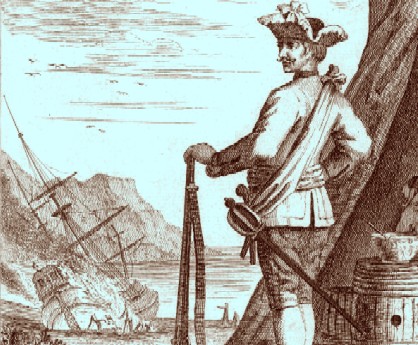
Artist: Joseph Nicholls
George Lowther Careening His Ship (1736)
The only supporting period evidence found for Lowther having a surgeon aboard when his ship was captured in October of 1723 comes from the newspapers, such as this quote from the Weekly Journal or British Gazetteer. "Lowder’s Doctor, and 7 of his Men, surrender’d themselves as forc’d Men to the Assiento Sloop [English vessel licensed to trade slaves with the Spaniards], and were carried Prisoners to St. Thomas."3 The doctor is not identified by name here and several details in this news report disagree with the facts found in both Johnson's book and a letter written by St. Christopher Governor John Hart to the Council of Trade and Plantations. Both sources state that Moore took sixteen prisoners (not eight) who were all tried at St. Christopher aka. St. Kitts (not St. Thomas).4 So even the newspaper's facts are questionable at best. Johnson lists fourteen of the pirates tried which includes an Andrew Hunter (convicted and hung), but no mention of a surgeon, let alone anyone named Robert Hunter. Governor Hart's letter lists the other two pirates who were convicted and then pardoned, neither of whom are named Robert Hunter.
In addition, there is no record of Lowther taking a vessel called Jeremiah & Anne, although in another trial, that of Bartholomew Roberts' men, Robert Johnson testifies that "he was forced out of the Jeremiah and Ann, Captain Turner, about twelve Months ago [around April, 1721]"5. Since Graham does not cite his sources it is impossible to check his facts. Based on the lack of period support, the fact that Roberts (not Lowther) appears to be the pirate who took the ship Graham identifies as having a Dr. Hunter aboard, and the presence of a Dr. Hunter in Johnson's account of Roberts, it would appear that Graham erroneously identified Bartholomew Robert's surgeon Hunter as having served with Lowther. Where he gets the given name Robert from is not clear. There was a Robert Hunter of Kilmarnock listed as a Surgeon-freeman among the physicians and surgeons of Glasgow in 17286, but there is no evident no connection to either the Dr. Hunter on Roberts' ship nor any surgeon who may have been on Lowther's ship.
Although the actual details of surgeons Hunter and Hamiton are shrouded in mystery, Robert's trial does reveal a bit more about surgeons William Child and Adam Comrie. George Wilson and Peter Scudamore are some of the few true pirate surgeons identified from this era, having joined the pirates willingly. Both signed Roberts' articles and were complete blackguards according to the evidence from the trial. Let's look at these four surgeons in more detail.
1 Daniel Defoe (Captain Charles Johnson), A General History of the Pyrates, Manuel Schonhorn, ed., 1999, pp. 273; 2 Pyrates Lately taken by Captain OGLE, 1723, p. 21; 3 Eric J. Graham, Seawolves: Pirates & the Scots, 2005, p. 109; 4 See CSPC America and West Indies, Vol. 34, Item 102 & Defoe (Charles Johnson), p. 317; 5 Pyrates Lately taken by Captain OGLE, 1723, p. 50; 6 Alexander Duncan, Memorials of the Faculty of Physicians and Surgeons of Glasgow, 1599-1850, 1896, p. 251
Adam Comrie and William Child
William Child was a surgeon on board the Mercy Galley in October of 1721 when he was taken along with surgeon Peter Scudamore. Fellow forced men Harry Glasby and Robert Lilburn testified that Child was "forced into their Ship at Calabas by Roberts against his Inclination, never perpetrating in any Act of Pyracy himself, or approving it in others."1 In his own defense, Child explained that he was opposed to serving the pirates, adding
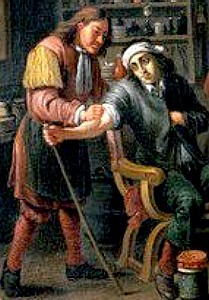
Artist: David Teniers the Younger
Surgeon Barber (17th c.)
that he already had "a good Employ whereon to build, and Friends to advance him in the World in an honest and reputable way of Livelyhood."2 This comment succinctly points out why the surgeon didn't need the pirates nearly as much as they needed the surgeon. Child served aboard the Royal Fortune, as surgeon's mate to chief surgeon Scudamore during "the [Royal Fortune's] Action with the Swallow[, being] down in the Hold."3 This fact was was probably mentioned during the trial because men who did not fight had a greater chance of being acquitted. Child was acquitted.
Adam Comrie was taken by Roberts' pirates out of the Elizabeth in January of 1722. He served with surgeon George Wilson aboard the pirate ship Ranger, which was captained by James Skyrme. John Sharp testified that Comrie served against his will, being first noticed and recommended by Agge Jacobson.4 John Sharp, master of the Elizabeth, testified that he heard Peter Scudamore "ask Roberts’ leave to force Comry, his surgeon, from him [Sharp], which was accordingly done, and with him carried also some of the ship’s medicines"5.
Comrie was one of three surgeons to be put up for vote for the office of chief surgeon (basically the surgeon in charge in Roberts' little fleet) along with George Wilson and Peter Scudamore.6 He seems like an odd choice, given that both Wilson and Scudamore actually wanted the job. He may have been put up simply because he was competent and diligent, something that neither of the other men appear to have been (as we shall see). Comrie lost the vote, probably much to his relief. Like Child, Comrie was in the hold during the battle with the Swallow and was also acquitted of the charge of piracy.
Once cleared, Comrie was active in testifying against other pirates in the crew including surgeon Peter Scudamore7, Agge Jacobson8, William Petty9, surgeon George Wilson10, John Phillips11 and William Fernon12.
1,2 Pyrates Lately taken by Captain OGLE, 1723, p. 33; 3 Pyrates Lately taken by Captain OGLE, p. 34; 4 Pyrates Lately taken by Captain OGLE, p. 37; 5 Captain Charles Johnson, The general history of the pyrates, 2nd ed, 1724, p. 309; 6 Pyrates Lately taken by Captain OGLE, p. 36; 7 Pyrates Lately taken by Captain OGLE, p. 35; 8 Pyrates Lately taken by Captain OGLE, p. 37; 9 Pyrates Lately taken by Captain OGLE, p. 42; 9 Pyrates Lately taken by Captain OGLE, p. 43; 10 Pyrates Lately taken by Captain OGLE, p. 42; 11 Pyrates Lately taken by Captain OGLE, p. 36; 12 Pyrates Lately taken by Captain OGLE, p. 46
Pirate Surgeon George Wilson
George Wilson has the somewhat dubious distinction of having been captured by Bartholomew
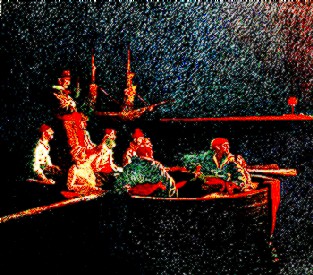
Artist: Howard Pyle (1911)
Roberts' crew of pirates twice. He was first captured while with the crew of John Tarlton's ship. At his trial, Thomas Tarlton told the court that when Wilson was captured by the pirates the first time, he, wanting "to oblige his new Company, had presently ask'd for the Pyrates Boat, to fetch the Medicine Chest away, when the Wind and Current proving too hard to contend with, they were drove on Shore at Cape Montzerado [present-day Monrovia, Liberia]."1
Wilson gives a different account of his first voyage with the pirates, explaining that when he was first captured, Bartholomew Roberts "told him, to his Sorrow, that he was to stay there, and ordered him to fetch his Chest, (not Medicines, as asserted,) which Opportunity he took to make his Escape; for the Boat's Crew happening to consist of five French and One English Man, all as willing as himself, they agreed to push the Boat on Shore, and trust themselves with the Negroes of Cape Montzerado: Hazardous, not only in Respect of the dangerous Seas that run there, but the Inhumanity of the Natives, who sometimes take a liking to humane Carcasses."2
Wilson remained stuck on the Cape for five months until Thomas Tarlton showed up looking to trade. The surgeon "represented his Hardships and starving Condition [to Tarlton], but was, in an unchristian Manner, both refused a Release of this
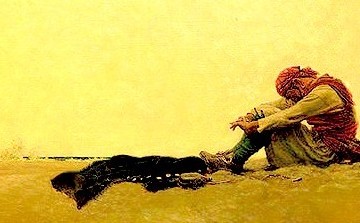
Artist: Howard Pyle - Marooned
(1909)
Captivity, or so much as a small Supply of Biscuit and salt Meat, because, as he said, he had been among the Pyrates."3
Not long after that, a French ship showed up and paid his ransom to the natives. However, "by Reason of a nasty leperous Indisposition he had contracted by hard and bad living, [he] was, to his great Misfortune set ashore at Sestos [in what is now Turkey] again".4 Note the rather interesting choice of words. One can't help but wonder if Wilson's indisposition was physical or mental the way he states it.
Wilson was finally ransomed by Captain John Sharp of the Elizabeth. Sharp testified that he took "Wilson off from Sestos, on this Coast, paying to the Negroes for his Ransom, the Value of three Pound five Shillings in Goods, for which he had taken a Note [from Wilson in lieu of payment], that he thought he had done a charitable Act in this, till meeting with one Captain Canning, he was ask'd, why he would release such a Rogue as Wilson was? For that he had been a Voluntier with the Pyrates, out of John Tarlton."5
After Wilson was captured by the pirates the second time, Sharp told the court that Wilson asked the pirates if they'd gotten hold of the note that Sharp had taken on his behalf. "Who not being able readily to tell, he reply'd, it's no Matter Mr. Sharp, I believe I shall hardly ever come to England, to pay it."6 Ever ready to apply the old oil, Wilson's counters this in his account to the court by saying that Sharp "generously procured his Release in the Manner himself has related, and for which he stands infinitely obliged."7 He may have been obliged, but he doesn't go so far as to suggest that he intended to pay back his debt.
Sharp's testimony mentions something else that proved to
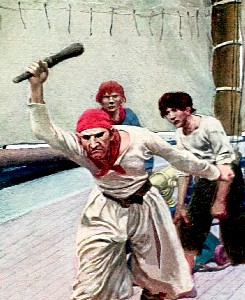
Artist: Howard Pyle
Then the Real Fight Began (1911)
be difficult for Wilson to explain in court. When the Elizabeth
was captured and Sharp became a prisoner of Roberts' crew he discovered Thomas Tarlton, the captain who refused to ransom Wilson the first time, had been captured by the pirates. "Tarlton was immediately on Wilson's Instigation, in a most sad manner misused and beat, and had been shot, through the Fury and Rage of some of those Fellows if the Town-side, (i. e. Liverpool) Men, had not hid him in a Stay-Sail, under the Bowsprit; for Moody and Harper, with their Pistols cock'd, searched every Corner of the Ship to find him, and came to this Deponent's [Sharp's] Hammock, whom they had like fatally to have mistaken for Tarlton, but on his calling out, they found their Error, and left him with this comfortable Anodyne [pain relieving medicine], That he was the honest Fellow who brought the Doctor [Wilson]."8
Wilson naturally explains it differently, suggesting that while he "thoughtlessly used some Reproaches of him, for his severe Treatment at Montzerado, but protests without Design his Words should have had so bad a Consequence".9 Wilson then blames Roberts for causing Tarlton to be beat for "contrary to any Intention of his it should so happen, because as a Stranger he might be supposed to have no Influence, and believes there were some other Motives for it."10
The deposition from Adam Comry, the Elizabeth's surgeon revealed similar aspects of Wilson's character
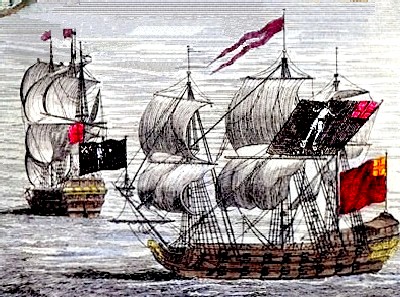
Bartholomew Roberts Ships Ranger and Royal Fortune (1724)
and were particularly damning to his claim to be unwilling to be among the pirates.
The Prisoner was very alert and chearful, [Comry] says, at meeting with Roberts, hailed him, told him he was glad to see him, and would come on Board presently, borrowing of the Deponent [Comry] a clean Shirt and Drawers, for his better Appearence and Reception, he signed their Articles willingly, and used Arguments with him to do the same, saying, they should make their Voyage in eight Months, to Brasil, Share 6 or 700 l. a Man, and then break up.11
When asked about this testimony, Wilson denied most of it, explaining that "if immaturity of Judgment had occasioned him to slip rash and inadvertent Words, or that he had paid any undue Compliments to Roberts, it was to ingratiate himself, as every Prisoner did, for a more civil Treatment, and in particular to procure his Discharge, which he had been promised, and was afraid would have been revoked, if such a Person as Comry did not remain there to supply his Room".12
Other witnesses said that Wilson "seem'd thoroughly satisfy'd with that Way of Life, and was particularly intimate with Roberts; they often scoffing at the Mention of a Man of War, and saying, if they should meet with any of the Turnip-Man's Ships, they would blow up, and go to H_ll together."13 Having such a relationship with Roberts didn't seem to blind the captain to Wilson's inherent faults as a surgeon, however. According to these witnesses "even Roberts told him, (on the Complaint of a wounded Man, whom he had refused to dress) that he was a double Rogue, to be there a second Time, and threat'ned to cut his Ears off."14
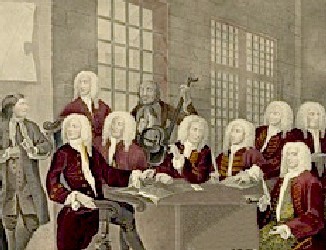
Wilson did have a couple of character witnesses from among the men who had been judged not guilty, although their testimony seems a bit tepid.
"Samuel Morwel says, that he has heard him [Wilson] bewail his Condition, while on Board the Pyrate, and desired one Thomas, to use, his Interest with Roberts, for a Discharge, saying, his Employ, and the little Fortune he had left at Home, would, he hop'd, exempt him the further Trouble of seeking his Bread at Sea."15
Nicholas Butler reported that in the 48 hours he was with the pirates, Wilson had deplored "the Wretchedness and ill Fortune of being confined in such Company."16
Wilson also explained that he was young and rash, had been with the pirates for only a month, did not use any weapons or fight on behalf of the pirates and had reported a planned mutiny by the pirates who were captured put on board the HMS Swallow. Wilson was judged guilty, but since the Swallow's commander agreed that Wilson had reported the planned mutiny, his "Execution [was] respited till the King's Pleasure be known."17
1 Captain Charles Johnson, The general history of the pyrates, 2nd ed, 1724, p. 314; 2 Ibid, p. 315; 3 Ibid,. p. 316; 4 Ibid.; 5 Ibid., p. 312; 6 Ibid., p. 313; 7 Ibid, p. 316.; 8 Ibid., p. 312-3; 9 Ibid., p. 316; 10 Ibid.; 11 Ibid., p. 313; 12 Ibid., p. 317; 13 Ibid., p. 314; 14 Ibid.; 15 Ibid., p. 315; 16 Ibid.; 17 Ibid., p. 317

